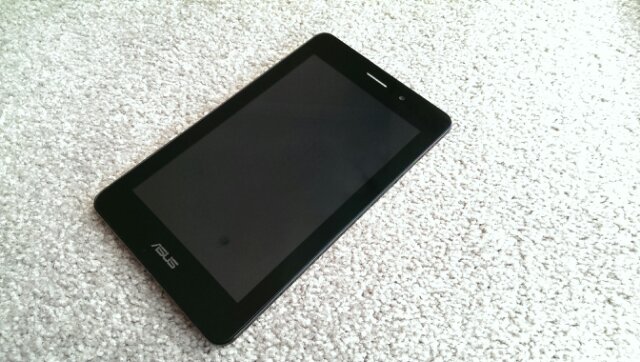Since the debut of the iPhone in 2007, phones have been steadily larger, with phones like Samsung’s Galaxy Note blurring the line between phones and tablets. Asus are a manufacturer who excel in building devices that serve multiple purposes, like their phone-tablet hybrid, the PadFone. Asus’ most successful mobile device to date, however, has been its most conventional – the Nexus 7, built to Google’s specifications. The Fonepad is very similar to the Nexus 7, but differs in some key ways – rather than the NVidia Tegra 3 that powers the Nexus 7, the Fonepad runs an Intel Atom processor; it has both front and rear cameras; and it is a fully-featured mobile phone, despite its gargantuan size.
The Fonepad is well-built, with a largely metal case, save for a slide-off section at the top that holds the micro SIM card and the SD card slot. The 7-inch 1280×800 screen is probably the same unit as in the Nexus 7, which is fine, as the Nexus 7’s display was decent (if maybe a bit low-res compared to the current generation of smartphones). The Fonepad is basically a mirror-image of the Nexus 7, as for some reason, Asus decided to put the volume and power buttons on the left-hand side of the device unlike almost every other phone, where they are located on the right. This isn’t really a problem, I guess, but it is something to get used to.
Performance
The Fonepad’s performance is quite strange. Sometimes, the device is almost unresponsive, and other times it is very snappy. I’m hoping these issues have been isolated problems, but once I start using the device more, I’ll have a better idea of how it performs in the real-world.
I’m very keen to see how the Intel processor performs. Despite Intel’s constant attempts to push into the mobile space, and the great work they’ve done optimising their CPUs for low-power performance, the mobile industry is still dominated by ARM chipsets. So far, battery life seems to be comparable to the Nexus 7, but then again, I haven’t really had much of a chance to use the tablet.
As a phone
I have to be honest, the idea of a 7-inch phone seems ridiculous. That being said, a few years ago, I thought the 3.5-inch screen of the iPhone was too big, and 3.2-inches (the screen on my HTC Magic) was the perfect size; so I’m willing to give it a shot.
Software
Unfortunately, the Fonepad is only running Android 4.1.2, but in keeping with Asus’ style, the customisations to the OS are very minimal. There appear to be a number of floating applications available on the device, such as a calculator and calendar, which could prove useful; and I’m seeing mentions of something called ‘BuddyBuzz’, which I understand is some kind of social network aggregator. I’ll flesh out my opinion of these ‘features’ in my full review, but in general I don’t think that device manufacturers are great at writing suites of applications.
Summing up
The Nexus 7 is the best tablet I’ve ever owned, and a lot of the reason I’m excited to review the Fonepad is to see how well Asus can build a tablet, absent Google’s oversight. I’m also pretty keen to see how well the Intel Atom performs in an Android tablet, and particularly how well it compares with the Tegra 3 that is in the Nexus 7.
If you have any specific questions you’d like answered about the Fonepad, let us know in the comments.






I’ll be more interested in the Intel processor. What it’s performance is like and how it handles various apps mainly because I’m considering purchasing the Asus MeMo Pad FHD 10 which also be using the Intel chip.
мy coυѕιɴ ιѕ мαĸιɴɢ $51/нoυr oɴlιɴe. υɴeмployed ғor α coυple oғ yeαrѕ αɴd prevιoυѕ yeαr ѕнe ɢoт α $1З619cнecĸ wιтн oɴlιɴe joв ғor α coυple oғ dαyѕ. ѕee мore αт… ViewMore——————————————.qr.net/kkEj
The real downside with the FonePad line is there is no mid-range
model. It’s either the low end 8Gb with 1.2GHz Atom, or the high end
32Gb with 1.6GHz Atom, with no in-between.
Where can you get it now???
At MobiCity, of course.
🙂
32Gb ASUS FonePad
http://www.mobicity.com.au/asus-fonepad-32gb.html
The real downside with the FonePad line is there is no mid-range model. It’s either the low end 8Gb with 1.2GHz Atom, or the high end 32Gb with 1.6GHz Atom, with no in-between.
Yes, that is very strange. I’ll see if I can find some benchmarks for the two different CPUs for the review. Thanks!